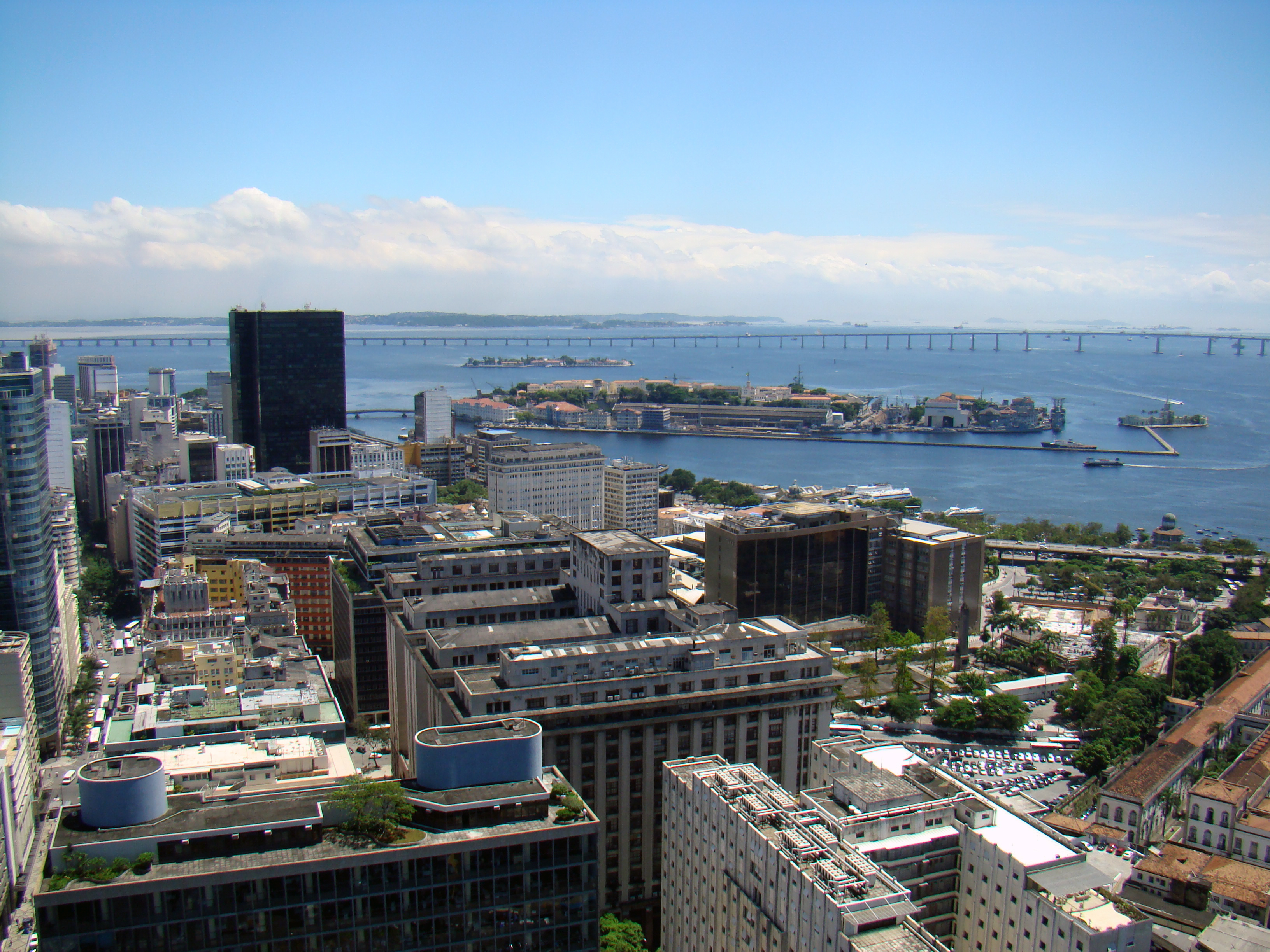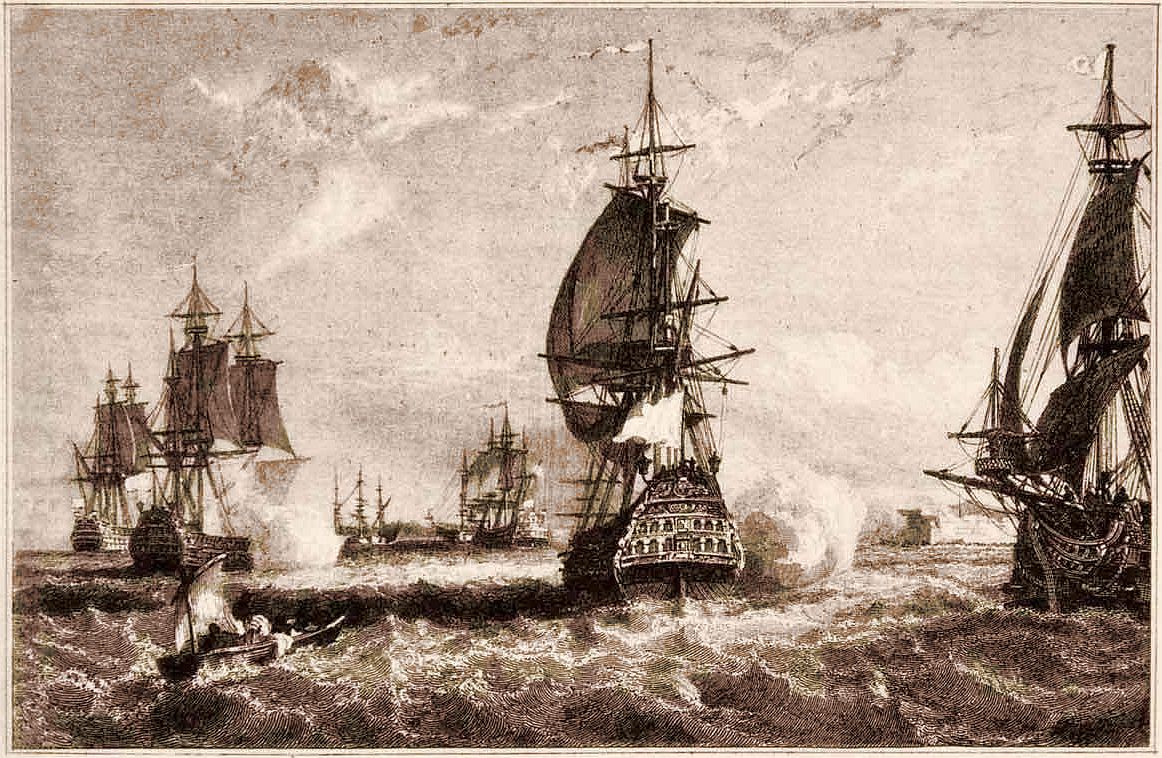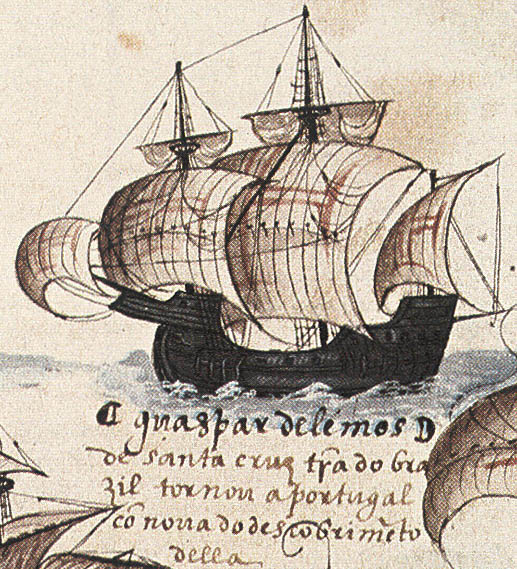|
Baía De Guanabara
Guanabara Bay (, , ) is an oceanic bay in Southeast Brazil in the state of Rio de Janeiro. On its western shore lie the cities of Rio de Janeiro and Duque de Caxias, and on its eastern shore are the cities of Niterói and São Gonçalo. Four other municipalities surround the bay's shores. Guanabara Bay is the second largest bay in area in Brazil (after the All Saints' Bay), at , with a perimeter of . Guanabara Bay is long and wide at its maximum. Its wide mouth is flanked at the eastern tip by the Pico do Papagaio (Parrot's Peak) and the western tip by Pão de Açúcar (Sugar Loaf). The name Guanabara comes from the Tupi language, ''goanã-pará'', from ''gwa'' "bay", plus ''nã'' "similar to" and ''ba'ra'' "sea". Other glosses include ''hidden water'', ''lagoon of the sea'', and ''bosom of the sea''. History Guanabara Bay was first encountered by Europeans on January 1, 1502, when Portuguese explorers Gaspar de Lemos and Gonçalo Coelho arrived on its shores. According to ... [...More Info...] [...Related Items...] OR: [Wikipedia] [Google] [Baidu] |
Rio De Janeiro (state)
Rio de Janeiro () is one of the States of Brazil, 27 federative units of Brazil. It has the second largest economy of Brazil, with the largest being that of the state of São Paulo (state), São Paulo. The state, which has 8.2% of the Brazilian population, is responsible for 9.2% of the Brazilian Gross domestic product, GDP. The state of Rio de Janeiro is located within the Brazilian geopolitical region classified as the Southeast Region, Brazil, Southeast (assigned by Brazilian Institute of Geography and Statistics, IBGE). Rio de Janeiro shares borders with all the other states in the same Southeast macroregion: Minas Gerais (North, N and Ordinal directions, NW), Espírito Santo (Ordinal direction, NE) and São Paulo (state), São Paulo (Ordinal directions, SW). It is bounded on the east and south by the South Atlantic Ocean. Rio de Janeiro has an area of . Its capital is the city of Rio de Janeiro, Rio de Janeiro, Rio de Janeiro, which was the capital of the Portuguese Colonial ... [...More Info...] [...Related Items...] OR: [Wikipedia] [Google] [Baidu] |
Rio De Janeiro (city)
Rio de Janeiro, or simply Rio, is the capital of the Rio de Janeiro (state), state of Rio de Janeiro. It is the List of cities in Brazil by population, second-most-populous city in Brazil (after São Paulo) and the Largest cities in the Americas, sixth-most-populous city in the Americas. Founded in 1565 by the Portuguese people, Portuguese, the city was initially the seat of the Captaincy of Rio de Janeiro, a domain of the Portuguese Empire. In 1763, it became the capital of the State of Brazil, a List of states of the Portuguese Empire, state of the Portuguese Empire. In 1808, when the Transfer of the Portuguese Court to Brazil, Portuguese Royal Court moved to Brazil, Rio de Janeiro became the seat of the court of Queen Maria I of Portugal. She subsequently, under the leadership of her son the prince regent John VI of Portugal, raised Brazil to the dignity of a kingdom, within the United Kingdom of Portugal, Brazil and the Algarves, United Kingdom of Portugal, Brazil, and Algar ... [...More Info...] [...Related Items...] OR: [Wikipedia] [Google] [Baidu] |
Nicolas Durand De Villegaignon
Nicolas Durand, sieur de Villegaignon, also Villegagnon (1510 – 9 January 1571) was a commander of the Knights of Malta, and later a French naval officer (vice-admiral of Brittany) who attempted to help the Huguenots in France escape persecution, before turning against them due to Eucharistic disputes. A notable public figure in his time, Villegaignon was a mixture of soldier, scientist, explorer, adventurer and entrepreneur. He fought pirates in the Mediterranean and participated in several wars. Villegagnon was born in Provins, Seine et Marne, France, a nephew of Philippe Villiers de L'Isle-Adam, Grand Master of the Order of Malta. He was received as a Knight of the Order in 1521. Ottoman campaigns in the Mediterranean and in Scotland Nicolas de Villegagnon fought in numerous campaigns against the Ottoman Empire. Although the French usually refrained from participating in actions against the Ottomans, due to the Franco-Ottoman alliance, Villegagnon's first allegiance was ... [...More Info...] [...Related Items...] OR: [Wikipedia] [Google] [Baidu] |
Huguenot
The Huguenots ( , ; ) are a Religious denomination, religious group of French people, French Protestants who held to the Reformed (Calvinist) tradition of Protestantism. The term, which may be derived from the name of a Swiss political leader, the Genevan burgomaster Besançon Hugues, was in common use by the mid-16th century. ''Huguenot'' was frequently used in reference to those of the Reformed Church of France from the time of the Protestant Reformation. By contrast, the Protestant populations of eastern France, in Alsace, Moselle (department), Moselle, and Montbéliard, were mainly Lutheranism, Lutherans. In his ''Encyclopedia of Protestantism'', Hans Hillerbrand wrote that on the eve of the St. Bartholomew's Day massacre in 1572, the Huguenot community made up as much as 10% of the French population. By 1600, it had declined to 7–8%, and was reduced further late in the century after the return of persecution under Louis XIV, who instituted the ''dragonnades'' to forcibly ... [...More Info...] [...Related Items...] OR: [Wikipedia] [Google] [Baidu] |
French Invasions In Brazil
French invasions in Brazil date back to the earliest days of Portuguese colonization up until the end of the 19th century. The attacks, initially as part of Francis I of France's challenge to the Treaty of Tordesillas, encouraged the practice of looting for the barter of brazilwood and supported the attempts to colonize the coast of Rio de Janeiro in 1555 and the coast of Maranhão in 1594. Until the middle of the end of the 16th century, the position of the French on the northern coast (which guaranteed them the opportunity to conquer the largest known hydrographic basin) and in the far east of the continent was very stable. Allied with the natives, they were about to attack Olinda, the Portuguese's main export town. The weakening of the French began when Portugal entered the Iberian Union and decisively defeated the Bretons and Normans in the vicinity of the Potiguara area. History Relations with the natives Before the Portuguese colonized part of the Brazilian territory, ... [...More Info...] [...Related Items...] OR: [Wikipedia] [Google] [Baidu] |
Tupiniquim
Tupiniquim (also Tupinã-ki, Topinaquis, Tupinaquis, Tupinanquins; plural: Tupiniquins) are an indigenous people of Brazil of the Tupi family, who now live in three indigenous territories (''Terras Indígenas'' in Portuguese). The indigenous territories (Caieiras Velhas, Pau-Brasil and Comboios) are located near the cities of Santa Cruz and Vila do Riacho in the municipality of Aracruz in northern Espírito Santo state, southeastern Brazil. Caieiras Velhas Indigenous Territory is located along the banks of the Piraquê-Açu River. The Pau-Brasil Indigenous Territory is near Sahy Creek. The Comboios Indigenous Territory is located on the banks of the Comboios River. A 2010 census determined the population of Tupiniquim in all three indigenous territories as 2,630. Territory Historically, the Tupiniquim inhabited a large tract of land along Brazil's coastline from approximately 200 km south of Salvador down to the São Mateus River. This area is north of the present-day ... [...More Info...] [...Related Items...] OR: [Wikipedia] [Google] [Baidu] |
Tamoio
The Tupi people, a subdivision of the Tupi-Guarani linguistic families, were one of the largest groups of indigenous peoples in Brazil before its colonization. Scholars believe that while they first settled in the Amazon rainforest, from about 2,900 years ago the Tupi started to migrate southward and gradually occupied the Atlantic coast of Southeast Brazil. Many Tupi people today are merged with the Guaraní people, forming the Tupi–Guarani languages. The Guarani languages are a subdivision of the Tupian languages. History The Tupi people inhabited 3/4 of all of Brazil's coast when the Portuguese first arrived there. In 1500, their population was estimated at 1 million people, nearly equal to the population of Portugal at the time. They were divided into tribes, each tribe numbering from 300 to 2,000 people. Some examples of these tribes are: '' Tupiniquim'', '' Tupinambá'', ''Potiguara'', ''Tabajara'', '' Caetés'', ''Temiminó'', ''Tamoios''. The Tupi were adept agr ... [...More Info...] [...Related Items...] OR: [Wikipedia] [Google] [Baidu] |
Indigenous Peoples In Brazil
Indigenous peoples in Brazil or Native Brazilians () are the peoples who lived in Brazil before European contact around 1500 and their descendants. Indigenous peoples of the Americas, Indigenous peoples once comprised an estimated 2,000 district tribes and nations inhabiting what is now Brazil. The 2010 Brazil census recorded 305 ethnic groups of Indigenous people who spoke 274 Indigenous languages of the Americas, Indigenous languages; however, almost 77% speak Portuguese language, Portuguese. Historically, many Indigenous peoples of Brazil were semi-nomadic and combined hunting, fishing, and hunter-gatherer, gathering with migratory agriculture. Many tribes were massacred by European settlers, and others assimilated into the growing European population Brazilians, Brazilian population. The Indigenous population was decimated by European diseases, declining from a pre-Columbian high of 2 million to 3 million to approximately 300,000 by 1997, distributed among 200 tribes. Accor ... [...More Info...] [...Related Items...] OR: [Wikipedia] [Google] [Baidu] |
Vasco Mariz
Vasco Mariz (Rio de Janeiro, — ) was a Brazilian historian, musicologist, writer and diplomat. Biography He received his musical training at the and graduated in law from the Federal University of Rio de Janeiro in 1943, and two years later he began his diplomatic career. Completing a further course in Diplomatic History in 1947, he was soon appointed vice-consul in Porto, later serving in various roles and positions in Rosario, Naples, Washington, D.C., New York City, Rome, until reaching the rank of minister in 1967, promoted by merit, and ambassador in 1971, appointed to represent Brazil in Ecuador and successively in Israel, Peru and East Germany, retiring in 1987. In his career as a diplomat, before becoming ambassador, he played the role of Brazilian delegate to several important international organizations – such as the UN, FAO, the OAS, GATT, UNESCO – and on several occasions such representations had clear cultural purposes, developing in the area of history, fo ... [...More Info...] [...Related Items...] OR: [Wikipedia] [Google] [Baidu] |
Gonçalo Coelho
Gonçalo Coelho (fl. 1501–04) was a Portuguese explorer who belonged to a prominent family in northern Portugal. He commanded two expeditions (1501–02 and 1503–04) which explored much of the coast of Brazil. Biography In 1501 Coelho was sent on an expedition to follow up on Pedro Álvares Cabral's discovery of Brazil. On 10 May, he sailed from Lisbon as "Captain General" of three caravels. Among his crew was a Florentine resident in Seville, Amerigo Vespucci. On 17 August his expedition made landfall off the Brazilian coast at about 5° S. The fleet continued south, reaching Guanabara Bay (23° S) on New Year's Day 1502, naming it "Rio de Janeiro". They sailed two degrees further south (reaching modern Cananéia), before leaving Brazil on 13 February 1502. If Amerigo Vespucci`s account is to be believed, the expedition reached the latitude "South Pole elevation 52° , in the ''cold'' latitudes of present-day Patagonia, reaching ''inhospitable seas and shores'' (or ''isla ... [...More Info...] [...Related Items...] OR: [Wikipedia] [Google] [Baidu] |
Gaspar De Lemos
Gaspar de Lemos (15th century) was a Portuguese explorer and captain of the supply ship of Pedro Álvares Cabral's fleet that arrived to Brazil. Gaspar de Lemos was sent back to Portugal with news of their discovery and was credited by the Viscount of Santarém as having discovered the Fernando de Noronha archipelago in the Atlantic Ocean. Personal life Very little is known about the life of Gaspar de Lemos. It is postulated that he was a part of the Morgada family, originally from the Kingdom of Galiza, but came to Portugal during the reign of Afonso IV (1325–1357). Upon his arrival back to Europe after participation in the exploration of the new world, the name Gaspar de Lemos disappears from the historical record, only to reappear later between 1536 and 1537 in India, under the service of Martim Afonso de Sousa. No further information has been discovered. Discoveries and Expeditions Gaspar de Lemos was the commander of a supply ship from Pedro Álvares Cabral' ... [...More Info...] [...Related Items...] OR: [Wikipedia] [Google] [Baidu] |
Guanabara Bay 1900
Guanabara may refer to: * Guanabara (state), a former state in Brazil * Guanabara Bay, a bay in Brazil * Guanabara (Joinville), a neighborhood in Santa Catarina state, Brazil * Jardim Guanabara, a neighborhood in Rio de Janeiro state, Brazil * Guanabara Esporte Clube * Taça Guanabara The Taça Guanabara ( English: Guanabara Cup) is an annual football tournament attached to the Campeonato Carioca, the state football league in the Rio de Janeiro state. It has been organized since 1965 by the Rio de Janeiro State Football Fe ... * MV ''Guanabara'' {{disambiguation, geo ... [...More Info...] [...Related Items...] OR: [Wikipedia] [Google] [Baidu] |







